Residential Solar Thermal Performance Considering Self-Shading Incidence between Tubes in Evacuated Tube and Flat Plate Collectors
Abstract
:1. Introduction
2. Materials and Methods
3. Results
3.1. Temperatures at the Outlets of the STCs
3.2. Temperatures at the Storage Outlets
3.3. Supplementary Energy Requirement for Residential Use
4. Discussion
5. Conclusions
Author Contributions
Funding
Institutional Review Board Statement
Informed Consent Statement
Conflicts of Interest
Abbreviations
| β | Slope angle |
| °C | Degrees Celsius |
| cm | Centimeters |
| CO2 | Carbon dioxide |
| DHW | Domestic hot water |
| ETC | Evacuated tube collector |
| ETC.w | Evacuated tube collector facing west |
| ETC.s | Evacuated tube collector facing south |
| FPC | Flat plate collector |
| FPC.e | Flat plate collector facing east |
| FPC.n | Flat plate collector facing north |
| IEA | International Energy Agency |
| kg | Kilograms |
| kWh | Kilowatt hours (energy) |
| LPG | Liquified petroleum gas |
| L | Liters |
| m2 | Square meters |
| masl | Meters above sea level |
| PV | Photovoltaic |
| STC | Solar-thermal collector |
| SO2 | Sulfur dioxide |
| Temp.Avg | Average temperature |
| USD | United States dollars |
| Wh/m2 | Watt-hours per square meter (energy) |
Appendix A

References
- Perez, R.; Perez, M. A Fundamental Look at Energy Reserves for the Planet. Int. Energy Agency SHC Program. Sol. Updat. 2009, 50, 4–6. Available online: http://www.iea-shc.org/data/sites/1/publications/2015-11-A-Fundamental-Look-at-Supply-Side-Energy-Reserves-for-the-Planet.pdf (accessed on 13 December 2021).
- Vázquez Espí, M. Una brevísima historia de la arquitectura solar. Por una Arquit. Urban. Contemp. 1999, pp. 1–31. Available online: http://habitat.aq.upm.es/boletin/n9/amvaz.html (accessed on 13 December 2021).
- Kalogirou, S. Solar thermal collectors and applications. Prog. Energy Combust. Sci. 2004, 30, 231–295. [Google Scholar] [CrossRef]
- Duffie, J.A. Solar technologies. Energy for Rural and Island Communities IV. In Proceedings of the 4th International Conference, Inverness, Scotland, 16–19 September 1985; pp. 275–280. [Google Scholar] [CrossRef]
- Ge, T.; Wang, R.; Xu, Z.; Pan, Q.; Du, S.; Chen, X.; Ma, T.; Wu, X.; Sun, X.; Chen, J. Solar heating and cooling: Present and future development. Renew. Energy 2018, 126, 1126–1140. [Google Scholar] [CrossRef]
- Lamnatou, C.; Cristofari, C.; Chemisana, D.; Canaletti, J. Building-integrated solar thermal systems based on vacuum-tube technology: Critical factors focusing on life-cycle environmental profile. Renew. Sustain. Energy Rev. 2016, 65, 1199–1215. [Google Scholar] [CrossRef] [Green Version]
- Valančius, R.; Jurelionis, A.; Jonynas, R.; Katinas, V.; Perednis, E. Analysis of Medium-Scale Solar Thermal Systems and Their Potential in Lithuania. Energies 2015, 8, 5725–5737. [Google Scholar] [CrossRef] [Green Version]
- Olczak, P.; Matuszewska, D.; Zabagło, J. The Comparison of Solar Energy Gaining Effectiveness between Flat Plate Collectors and Evacuated Tube Collectors with Heat Pipe: Case Study. Energies 2020, 13, 1829. [Google Scholar] [CrossRef] [Green Version]
- Benli, H. Potential application of solar water heaters for hot water production in Turkey. Renew. Sustain. Energy Rev. 2016, 54, 99–109. [Google Scholar] [CrossRef]
- Rosas-Flores, J.A.; Rosas-Flores, D.; Zayas, J.L.F. Potential energy saving in urban and rural households of Mexico by use of solar water heaters, using geographical information system. Renew. Sustain. Energy Rev. 2016, 53, 243–252. [Google Scholar] [CrossRef]
- Han, J.; Mol, A.; Lu, Y. Solar water heaters in China: A new day dawning. Energy Policy 2010, 38, 383–391. [Google Scholar] [CrossRef]
- Ayompe, L.; Duffy, A.; Mc Keever, M.; Conlon, M.; McCormack, S. Comparative field performance study of flat plate and heat pipe evacuated tube collectors (ETCs) for domestic water heating systems in a temperate climate. Energy 2011, 36, 3370–3378. [Google Scholar] [CrossRef] [Green Version]
- Chow, T.-T.; Dong, Z.; Chan, L.-S.; Fong, K.-F.; Bai, Y. Performance evaluation of evacuated tube solar domestic hot water systems in Hong Kong. Energy Build. 2011, 43, 3467–3474. [Google Scholar] [CrossRef]
- Adsten, M.; Perers, B.; Wäckelgård, E. The influence of climate and location on collector performance. Renew. Energy 2002, 25, 499–509. [Google Scholar] [CrossRef]
- Tanha, K.; Fung, A.S.; Kumar, R. Performance of two domestic solar water heaters with drain water heat recovery units: Simulation and experimental investigation. Appl. Therm. Eng. 2015, 90, 444–459. [Google Scholar] [CrossRef]
- Sokhansefat, T.; Kasaeian, A.; Rahmani, K.; Heidari, A.H.; Aghakhani, F.; Mahian, O. Thermoeconomic and environmental analysis of solar flat plate and evacuated tube collectors in cold climatic conditions. Renew. Energy 2018, 115, 501–508. [Google Scholar] [CrossRef]
- Norton, B. Anatomy of a solar collector: Developments in Materials, Components and Efficiency Improvements in Solar Thermal Collector Systems. Refocus 2006, 7, 32–35. [Google Scholar] [CrossRef]
- Munari, C. Architectural Integration and Design of Solar Thermal Systems; École Polytechnique Fédérale de Lausanne: Lausanne, Suisse, 2009. [Google Scholar]
- IEA SHC Task 41. SOLAR ENERGY SYSTEMS IN ARCHITECTURE integration criteria and guidelines. 2012. Available online: http://leso2.epfl.ch/solar/pdf/SolThePh.pdf (accessed on 13 December 2021).
- Zalamea, E.; Barrgán-Escandón, A. Revisión conjunta de fuentes primordiales para autoabastecimiento energético urbano e incidencia solar como principal fuente, en contexto de ciudad ecuatorial-andina. ACI Av. Cienc. Ing. 2020, 12, 21. [Google Scholar] [CrossRef]
- Nieto, L.F.M.; Mora-López, L. A new model to predict the energy generated by a photovoltaic system connected to the grid in low latitude countries. Sol. Energy 2014, 107, 423–442. [Google Scholar] [CrossRef]
- Fitriaty, P.; Shen, Z. Predicting energy generation from residential building attached Photovoltaic Cells in a tropical area using 3D modeling analysis. J. Clean. Prod. 2018, 195, 1422–1436. [Google Scholar] [CrossRef]
- Izquierdo-Torres, I.F.; Pacheco-Portilla, M.G.; Gonzalez-Morales, L.G.; Zalamea-León, E.F. Simulación fotovoltaica considerando parámetros de integración en edificaciones. Ingenius 2018, 21, 21–31. [Google Scholar] [CrossRef] [Green Version]
- Luque, A.; Hegedus, S. Handbook of Photovoltaic Science and Engineering Handbook of Photovoltaic Science and Engineering, II; John Wiley & Sons: West Sussex, UK, 2011. [Google Scholar]
- Recalde, C.; Cisneros, C.; Avila, C.; Logroño, W.; Recalde, M. Single Phase Natural Circulation Flow through Solar Evacuated Tubes Collectors on the Equatorial Zone. Energy Procedia 2015, 75, 467–472. [Google Scholar] [CrossRef] [Green Version]
- Beckman, W.A.; Klein, S.A.; Duffie, J.A. Solar heating design, by the f-chart method. NASA STI/Recon Tech. Rep. A 1977, 78, 31071. [Google Scholar]
- Hudon, K. Chapter 20- Solar Energy- Water Heating. In Future Energy, 2nd ed.; Elsevier Inc.: London, UK, 2014; pp. 351–433. [Google Scholar]
- Sarbu, I.; Sebarchievici, C. Solar Collectors. In Solar Heating and Cooling Systems Fundamentals, Experiments and Applications; Elsevier: Amsterdam, The Netherlands, 2017; pp. 29–97. [Google Scholar]
- APS Products, “Separated Pressure Solar Water Heater”. 2020. Available online: http://www.aps-china.net/aps/ArticleShow1.asp?ArticleID=4697 (accessed on 13 December 2021).
- Graphisoft@. Archicad 24. 2021. Available online: https://www.graphisoft.es/archicad/ (accessed on 21 February 2021).
- MEGA, “Mega TimerTMControl Units”. 2021. Available online: https://www.megaendustri.com.tr/En/ProductsMegatimer (accessed on 12 December 2021).
- Autonic, “Autonic Serie TM”. 2021. Available online: https://www.autonics.com/series/3000413 (accessed on 13 December 2021).
- Sigüencia, J.C.; Gómez, O.T. Obtención de ACS con energía solar en el cantón Cuenca y análisis de la contaminación ambiental. Ingenius 2018, 89–101. [Google Scholar] [CrossRef]
- Delta-T Devices, “WS-GP2 Advanced Automatic Weather Station System”. 2019. Available online: https://www.delta-t.co.uk/product/ws-gp2/ (accessed on 4 March 2019).
- Ministerio de Sanidad Consumo y Bienestar Social. Sistemas de Agua Caliente Sanitaria; Ministerio de Sanidad Consumo y Bienestar Social: Madrid, España, 2003; pp. 1–25. [Google Scholar]
- Ministerio de Desarrollo Urbano y Vivienda. NEC-HS-ER, Sistemas Solares Térmicos Para Agua Caliente Sanitaria (ACS)–Aplicaciones Menores A 100 °C; Ministerio de Desarrollo Urbano y Vivienda: Quito, Ecuador, 2020. [Google Scholar]
- Ferroli Inc. Que Temperatura debe Tener el agua Caliente Sanitaria? 2017. Available online: https://blog.ferroli.es/que-temperatura-debe-tener-el-agua-caliente-sanitaria/ (accessed on 9 March 2021).
- Moldovan, M.; Visa, I.; Burduhos, B. Experimental Comparison of Flat Plate and Evacuated Tube Solar Thermal Collectors for Domestic Hot Water Preparation in Education Facilities. J. Sustain. Dev. Energy Water Environ. Syst. 2020, 8, 293–303. [Google Scholar] [CrossRef]
- Shah, L.; Furbo, S. Vertical evacuated tubular-collectors utilizing solar radiation from all directions. Appl. Energy 2004, 78, 371–395. [Google Scholar] [CrossRef]
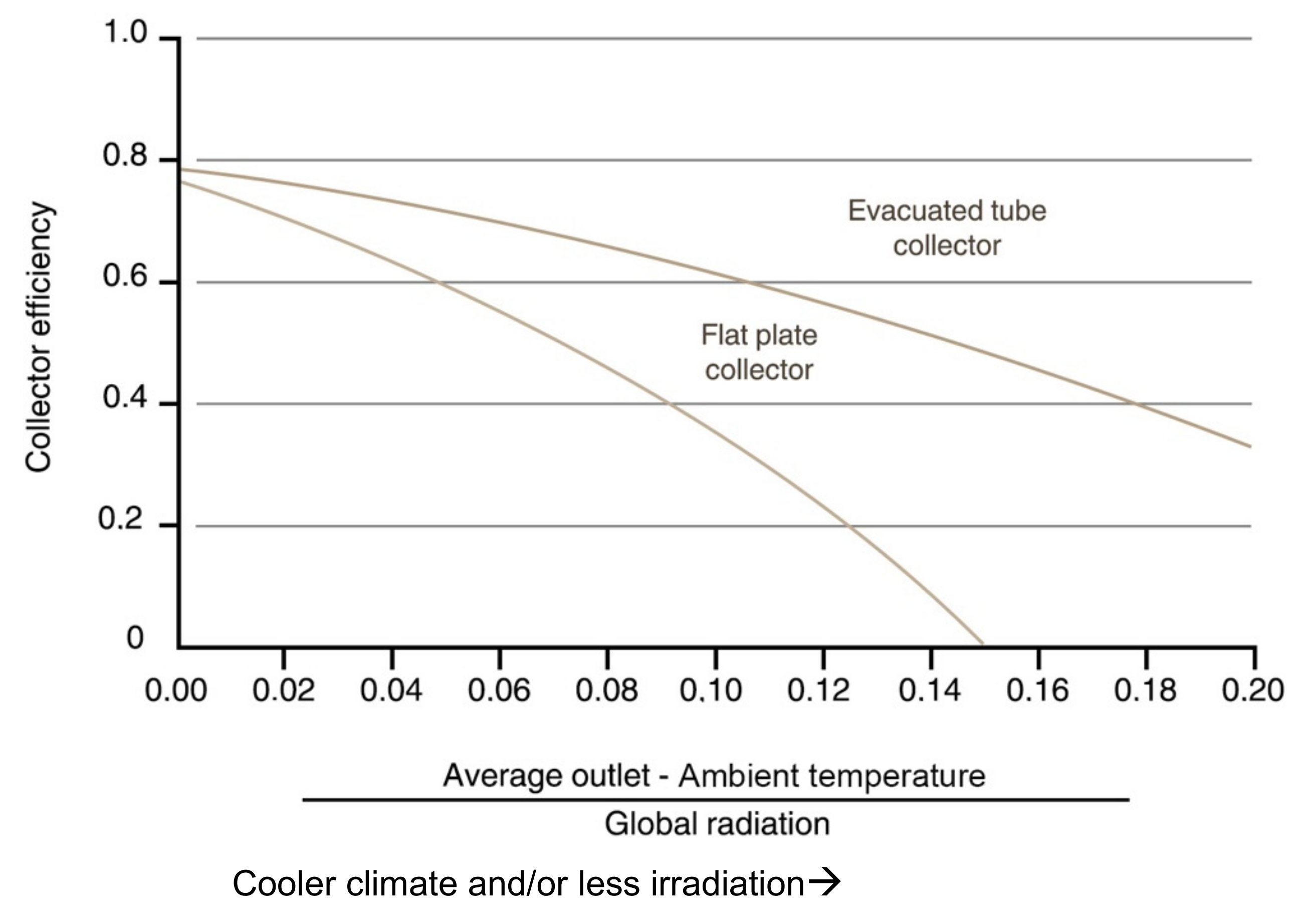
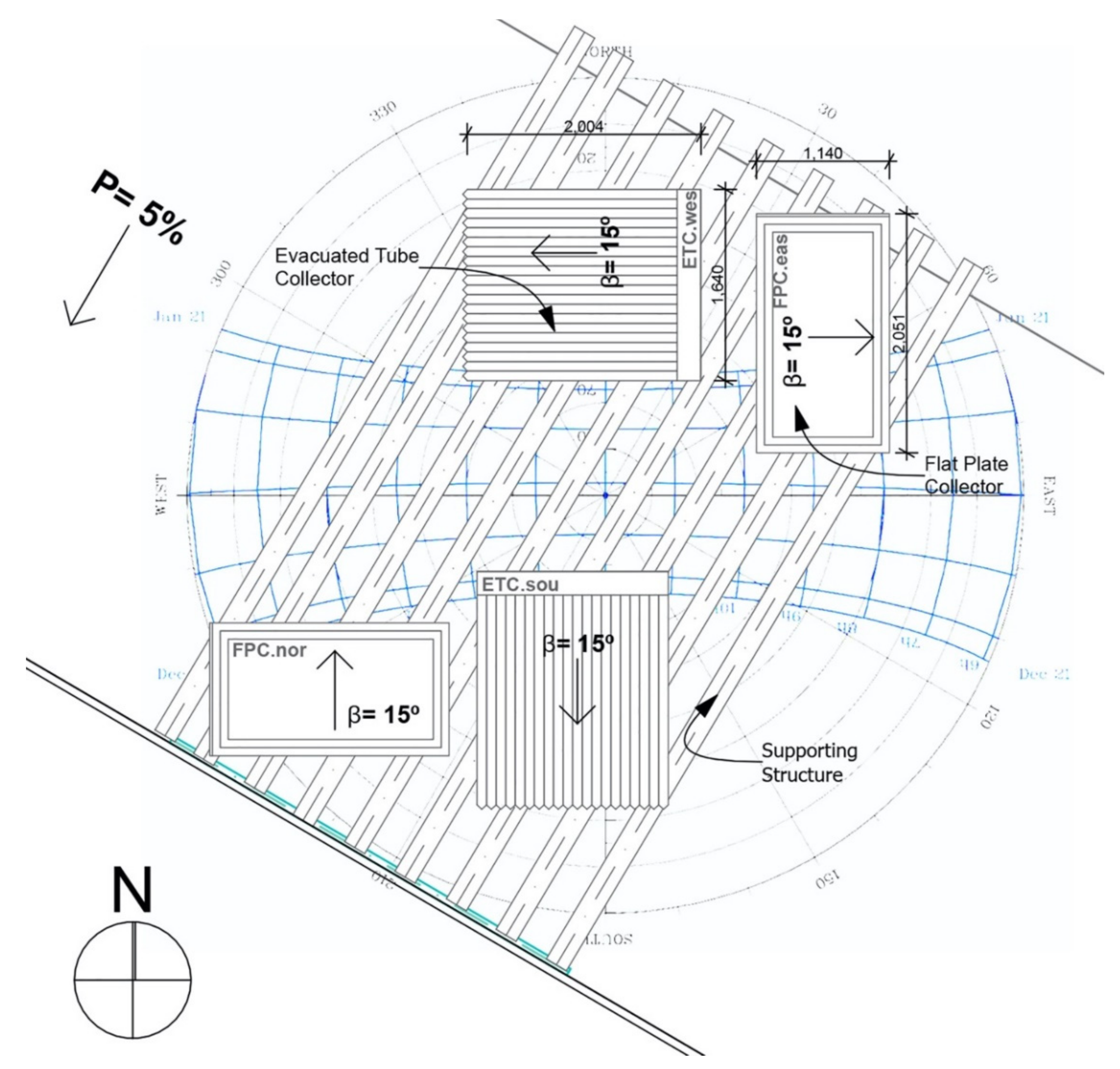
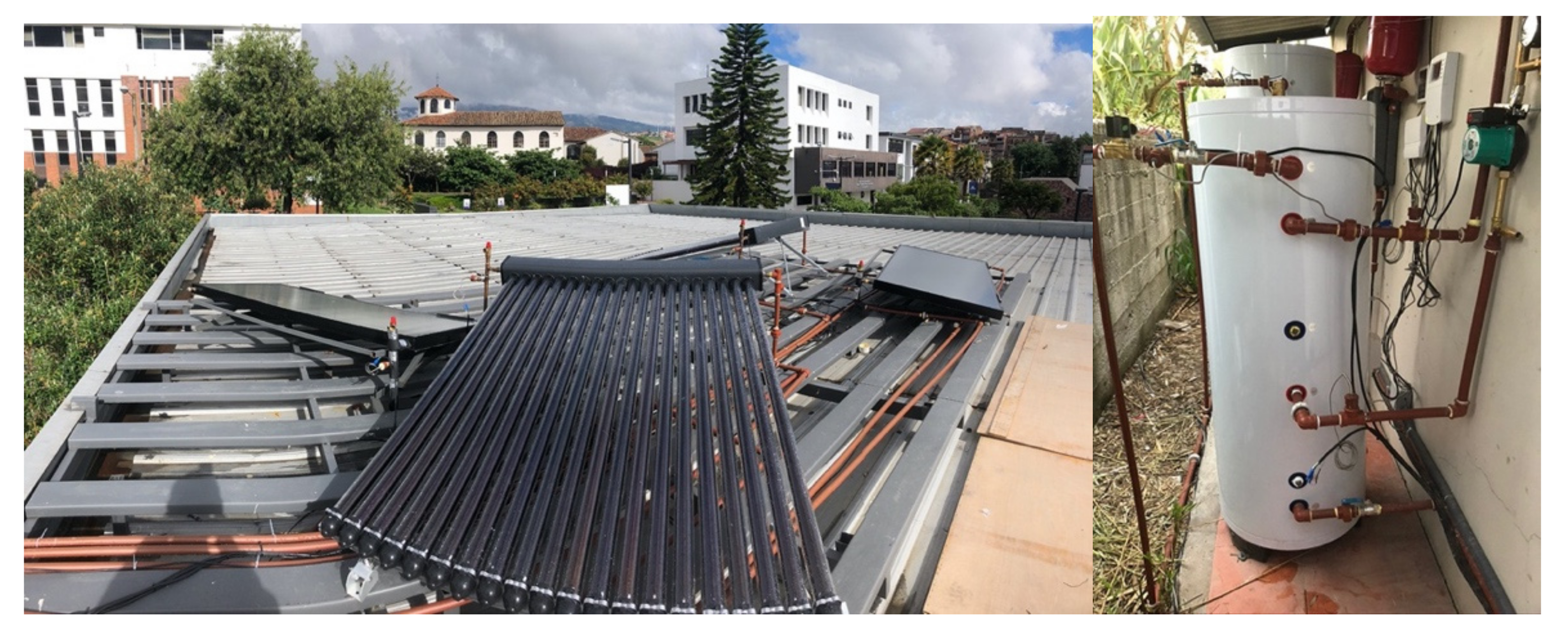

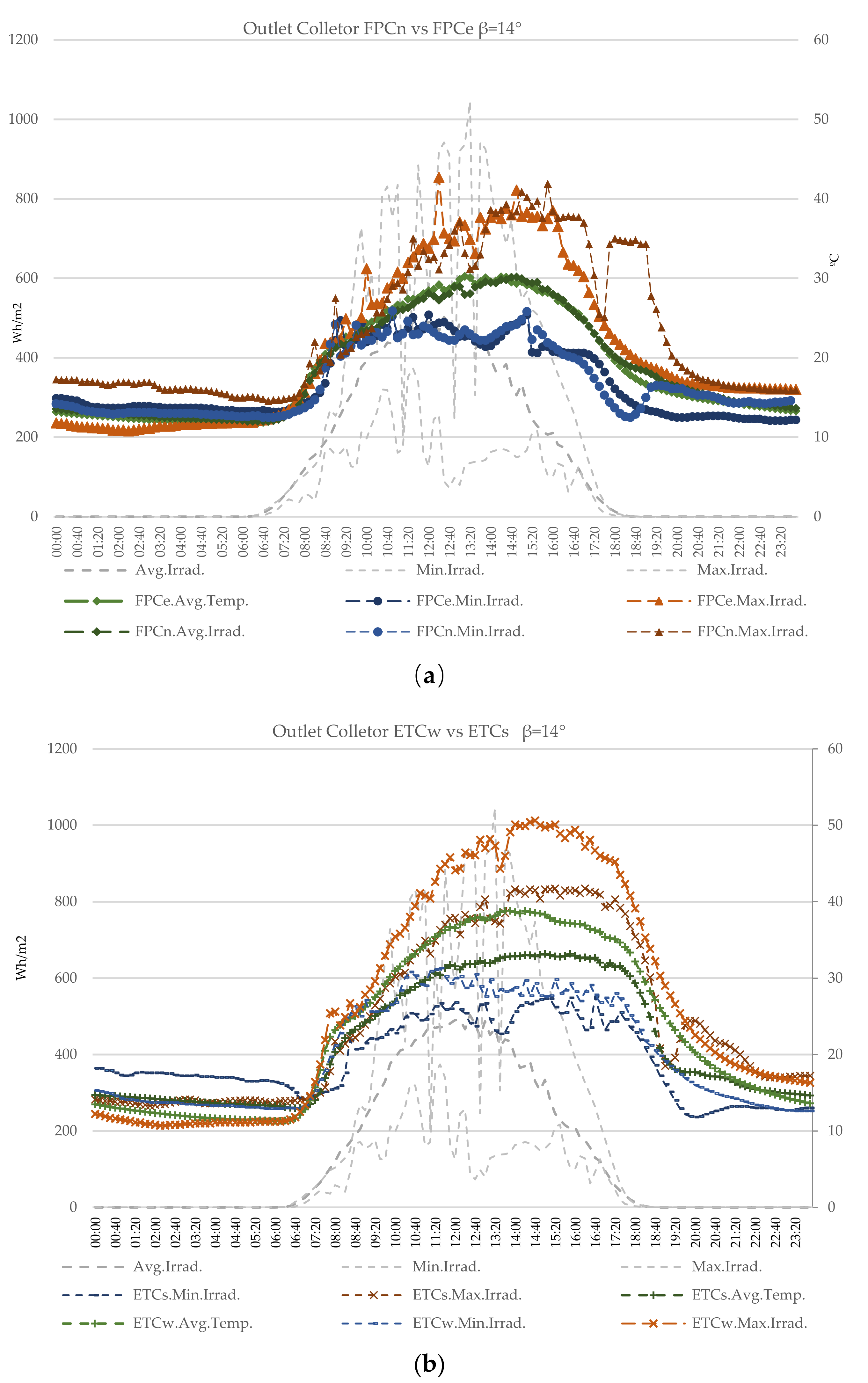
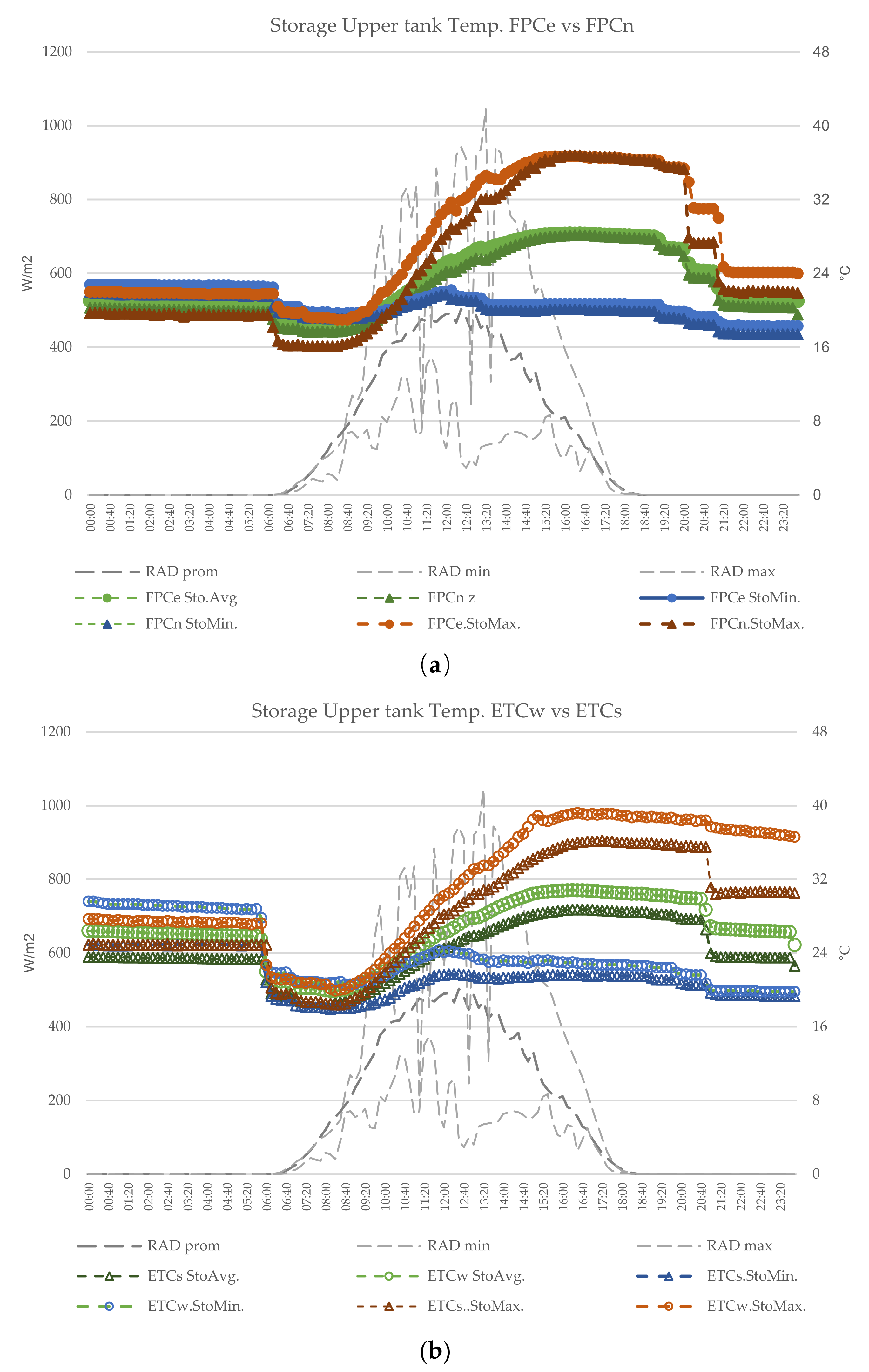
| Timetable/STC | ETC.w | ETC.s | FPC.n | FPC.e | Volume of Hot Water Evacuated (L) |
|---|---|---|---|---|---|
| Morning 1 Shower | 06:00 | 06:05 | 06:10 | 06:15 | 52 |
| Morning 2 Hand wash basins | 06:55 | 07:00 | 07:05 | 07:10 | 20 |
| Morning 3 Dishwasher | 07:50 | 07:55 | 08:00 | 08:05 | 8 |
| Afternoon 1 Kitchen | 12:00 | 12:15 | 12:30 | 12:45 | 16 |
| Afternoon 2 Dishwasher | 13:15 | 13:30 | 13:45 | 14:00 | 16 |
| Night 1 Kitchen | 19:00 | 19:05 | 19:10 | 19:15 | 16 |
| Night 2 Dishwasher | 19:55 | 20:00 | 20:05 | 20:10 | 20 |
| Night 3 Shower | 20:50 | 20:55 | 21:00 | 21:05 | 52 |
| Average Daily Irradiation Collector Water Outlet Temperature. Maximum and Average Temperature Comparative Analysis (°C) for 3177 Wh/m2 Daily Solar Energy Scenario | Low-Irradiation Day Collector Water Outlet Temperature. Maximum and Average Temperature Comparative Analysis (°C) for 1565 Wh/m2 Solar Energy Scenario | High-Irradiation Day Collector Water Outlet Temperature. Maximum and Average Temperature Comparative Analysis (°C) for 5195 Wh/m2 Daily Solar Energy Scenario | |||||||||
|---|---|---|---|---|---|---|---|---|---|---|---|
| Average Temperature Detected(°C) | Average Temperature Detected (°C) | Average Temperature Detected (°C) | |||||||||
| FPC.e | FPC.n | ETC.s | ETC.w | FPC.e. | FPC.n. | ETC.s. | ETC.w | FPC.e | FPC.n | ETC.s | ETC.w |
| 18.8 | 18.9 | 21.7 | 23.4 | 16.9 | 16.9 | 19.3 | 20.2 | 21.3 | 23.8 | 24.8 | 27.2 |
| Temperature difference against the same technology outlet collector (°C) | Temperature difference against the same technology outlet collector (°C) | Temperature difference against the same technology outlet collector (°C) | |||||||||
| −0.1 | 0.1 | −1.7 | 1.7 | 0.0 | 0.0 | −1.0 | 1.0 | −2.5 | 2.5 | −2.4 | 2.4 |
| Maximum Temperature Detected (°C) | Maximum Temperature Detected (°C) | Maximum Temperature Detected (°C) | |||||||||
| FPC.e | FPC.n | ETC.s | ETC.w | FPC.e | FPC.n | ETC.s | ETC.w | FPC.e | FPC.n | ETC.s | ETC.w |
| 30.2 | 30.1 | 33.2 | 38.8 | 25.4 | 25.8 | 27.6 | 31.4 | 41.1 | 40.9 | 41.7 | 50.6 |
| Temperature difference against the same technology outlet collector (°C) | Temperature difference against the same technology outlet collector (°C) | Temperature difference against the same technology outlet collector (°C) | |||||||||
| 0.1 | −0.1 | −5.6 | 5.6 | −0.4 | 0.4 | −3.7 | 3.7 | 0.2 | −0.2 | −8.9 | 8.9 |
| Average Irradiation Day Outlet Storage Temperature and Comparative analysis (°C) for 3177 Wh/m2 Daily Solar Energy Scenario | Low-Irradiation Day Outlet Storage Temperature and Comparative Analysis (°C) for 1565 Wh/m2 Daily Solar Energy Scenario | High-Irradiation Day Outlet Storage Temperature and Comparative Analysis (°C) for 5195 Wh/m2 Daily Solar Energy Scenario | |||||||||
|---|---|---|---|---|---|---|---|---|---|---|---|
| Average Temperature (°C) | Average Temperature (°C) | Average Temperature (°C) | |||||||||
| FPC.e | FPC.n | ETC.s | ETC.w | FPC.e | FPC.n | ETC.s | ETC.w | FPC.e | FPC.n | ETC.s | ETC.w |
| 23.1 | 22.4 | 24.2 | 26.4 | 20.8 | 20.1 | 21.4 | 23.8 | 27.2 | 25.2 | 28.2 | 31.1 |
| Temperature difference against the same technology outlet storage(°C) | Temperature difference against the same technology outlet storage (°C) | Temperature difference against the same technology outlet storage (°C) | |||||||||
| 0.7 | −0.7 | −2.1 | 2.1 | 0.8 | −0.8 | −2.3 | 2.3 | 2.0 | −2.0 | −3.0 | 3.0 |
| Maximum Temperature Detected (°C) | Maximum Temperature Detected (°C) | Maximum Temperature Detected (°C) | |||||||||
| FPC.e | FPC.n. | ETC.s | ETC.w | FPC.e | FPC.n | ETC.s | ETC.w | FPC.e. | FPC.n | ETC.s | ETC.w Max |
| 28.3 | 28.1 | 28.7 | 30.8 | 22.2 | 21.7 | 21.7 | 24.3 | 36.7 | 36.8 | 36.2 | 39.2 |
| Temperature difference against the same technology outlet storage(°C) | Temperature difference against the same technology outlet storage (°C) | Temperature difference against the same technology outlet storage (°C) | |||||||||
| 0.2 | −0.2 | −2.1 | 2.1 | 0.5 | −0.5 | −2.6 | 2.6 | −0.1 | 0.1 | −3.0 | 3.0 |
| Total Energy Shortfall (kWh/day) | ||||
|---|---|---|---|---|
| STC | Irradiation Conditions | % Comparative avg. Energy Requirement vs. Minimum avg. Requirement | ||
| Irrad.Min (1565 Wh/m2) | Irrad.Max (5195 Wh/m2) | Irrad.Avg. 3177 (Wh/m2) | ||
| FPC.e | 6.8 | 5.1 | 6.2 | 116.5% |
| FPC.n | 7.0 | 5.6 | 6.5 | 120.6% |
| ETC.s | 6.6 | 4.7 | 5.9 | 109.8% |
| ETC.w (base) | 6.1 | 4.2 | 5.4 | 100.0% |
Publisher’s Note: MDPI stays neutral with regard to jurisdictional claims in published maps and institutional affiliations. |
© 2021 by the authors. Licensee MDPI, Basel, Switzerland. This article is an open access article distributed under the terms and conditions of the Creative Commons Attribution (CC BY) license (https://creativecommons.org/licenses/by/4.0/).
Share and Cite
Zalamea-Leon, E.; Barragán-Escandón, E.A.; Calle-Sigüencia, J.; Astudillo-Flores, M.; Juela-Quintuña, D. Residential Solar Thermal Performance Considering Self-Shading Incidence between Tubes in Evacuated Tube and Flat Plate Collectors. Sustainability 2021, 13, 13870. https://doi.org/10.3390/su132413870
Zalamea-Leon E, Barragán-Escandón EA, Calle-Sigüencia J, Astudillo-Flores M, Juela-Quintuña D. Residential Solar Thermal Performance Considering Self-Shading Incidence between Tubes in Evacuated Tube and Flat Plate Collectors. Sustainability. 2021; 13(24):13870. https://doi.org/10.3390/su132413870
Chicago/Turabian StyleZalamea-Leon, Esteban, Edgar A. Barragán-Escandón, John Calle-Sigüencia, Mateo Astudillo-Flores, and Diego Juela-Quintuña. 2021. "Residential Solar Thermal Performance Considering Self-Shading Incidence between Tubes in Evacuated Tube and Flat Plate Collectors" Sustainability 13, no. 24: 13870. https://doi.org/10.3390/su132413870
APA StyleZalamea-Leon, E., Barragán-Escandón, E. A., Calle-Sigüencia, J., Astudillo-Flores, M., & Juela-Quintuña, D. (2021). Residential Solar Thermal Performance Considering Self-Shading Incidence between Tubes in Evacuated Tube and Flat Plate Collectors. Sustainability, 13(24), 13870. https://doi.org/10.3390/su132413870






